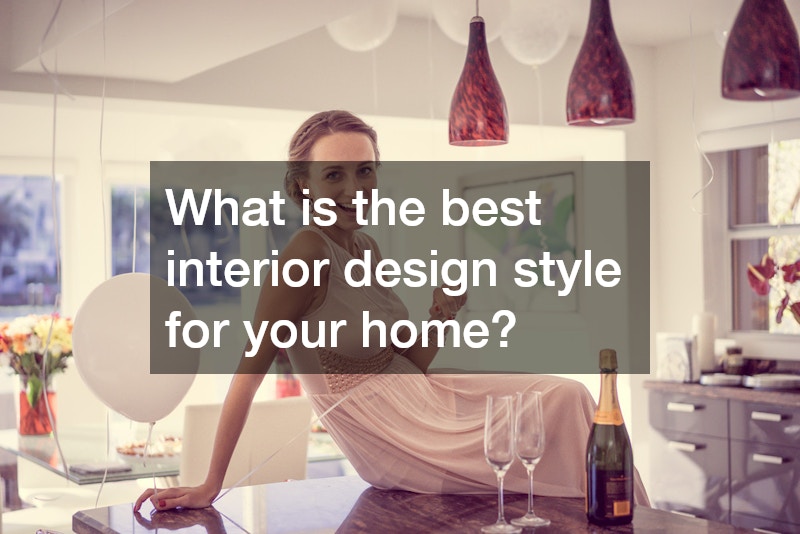It can be overwhelming to choose the right interior design style for you home. There are so many choices, from timeless classics to modern minimalism. It’s easy for you to feel overwhelmed. A well-designed house reflects your personality and lifestyle. It also creates an inviting environment. This article offers tips on choosing the right interior style, and provides examples of popular styles that can inspire your decision making process.
Consider Your lifestyle and daily needs
Your home should be a reflection of your daily life and lifestyle. Consider how you and your loved ones will use the space. Have you got pets or children that need easy-to clean surfaces? Are you a frequent host? Do you need a place to relax after a long day? These questions will allow you to determine the mood and functionality of your interior design.
Families with small children may choose durable materials such as leather or performance fabric for their furniture, and forgo coffee tables with sharp edges. A single professional may prefer sleek, modern designs which double as stylish entertainment spaces.
Timber elements are a great option for those who enjoy natural aesthetics. They’re durable and can be incorporated into many different home designs. Timber accents or flooring create warmth, and they blend well with a variety of styles from Scandinavian to rustic. Design choices should be in line with your lifestyle, to avoid creating an area that is beautiful but does not function as you need it to.
Set a budget and stick to it
Establish a realistic budget before you begin any interior design project. Knowing how much money you are willing to spend on interior design will help guide your decision. Budgeting allows you to allocate your funds efficiently, and focus on areas that have the greatest impact, such as furniture, flooring or feature walls.
Mixing high-quality pieces of furniture with affordable finds can provide cost-effective options for design. You could, for example, spend a lot on a statement couch while buying decorative items such as cushions, rugs and artwork at local markets or budget retailers. Remember, a cohesive design doesn’t always require a hefty price tag.
Consider the climate of Australia when choosing your materials. Long-term, investing in materials that are resistant to heat, humidity or cooler temperatures will save you money. Selecting durable fabrics for outdoor furniture and curtains will ensure that they last longer in Australia’s rain and sun.
Find Inspiration by Researching

Inspiration can be found everywhere. Explore different styles by looking at interior design magazines, Pinterest boards and Instagram accounts. Note recurring themes and elements that you are drawn to. These could be colour palettes or furniture styles. These patterns can help you narrow down your choices.
Australian homes are often open-plan, with natural light and an outdoor connection. Be sure to pay attention to the way these elements have been incorporated into the designs that you like. Large sliding glass doors and light wood furniture are popular options for homes that want to create a seamless flow between indoors and outdoors.
To experience the furniture and design in person, visit local showrooms or stores that sell home decor. This approach lets you see how the item will fit in your home, and allows you to assess comfort and quality. Do not hesitate to collect fabric samples or paint swatches to see how different colours and textures appear in your room under different lighting conditions.
Define Your Personal Style
Interior design should reflect both your personality and tastes. Identify the styles that appeal to you. You may prefer the simplicity and clean lines of modern designs, but you might also gravitate to the ornate details in traditional styles. You may prefer a mix of the two, creating a unique eclectic style.
Popular design styles include:
- Modern: Simple lines, neutral color palettes and functional furniture.
- Hamptons : Light, airy spaces featuring coastal elements such as whitewashed wood and nautical accents.
- Scandinavian design: Light wood, soft textures and neutral colors.
- Industrial: Exposed Brick, Metal Accents, and Reclaimed Wood.
- Bohemian : A mixture of colours, patterns and textures to create a relaxed, eclectic feel.
- Mid-Century Modern : Retro-inspired furnishings with sleek silhouettes, organic shapes and organic forms.
Blending styles can create an environment that is uniquely you. You could, for example, combine Scandinavian furniture and industrial lighting to create a balance between softness and edge.
Consult an expert
A professional interior designer will save you time and give a more polished outcome. DIY design is fun and can be cost-effective. Designers can create cohesive layouts and maximise space. They can also source unique pieces that suit your style.
Provide a detailed brief to the designer you hire, outlining your budget and style preferences. Also, include any practical requirements. Check their portfolio to make sure their aesthetic matches your vision. Many designers offer consultations, so you can benefit from their expertise even if your project is completed independently.
If you have a smaller budget, consult with designers who specialize in virtual or e-decorating services. This method is often less expensive and still provides tailored advice.
Select a focal point
A focal point is a feature that anchors a room’s design and draws attention. It could be an artwork, a light fixture that makes a statement, a fireplace or a large picture window with a beautiful view.
Consider the layout and function of the room when choosing a focal point. A bold sofa or oversized rug is a great focal point for living rooms. A striking pendant light over the dining table can add drama and focus to the room. For visual interest in bedrooms, choose an upholstered headboard or textured wallpaper.
After you have chosen your focal point, design the rest of the space around it. Make sure that other elements do not compete with your focal point, but rather complement it. If you have chosen a colorful artwork to be the focal point of your room, make sure that all surrounding furniture and décor is more subdued so it can shine.
Texture and layers are important to consider
Texture and layers are important in a well-designed room. These elements give your home depth and interest, which makes it more inviting.
The addition of rugs, throws, and cushions can elevate any room. Mixing materials such as leather, wool, and linen will give you a tactile and rich experience. Natural elements such as rattan or jute can enhance warmth and connection with the environment.
Consider adding dimension to your walls by using textured wallpapers, decorative panelling or gallery walls. The flooring options, such as polished concrete, timber or patterned tile, can also influence the overall texture of a room.
Prioritise Lighting
Lighting plays a major role in interior design. It affects both mood and functionality. Well-lit spaces are welcoming and add to the aesthetic of the room. Mix ambient, task and accent lighting for a balanced, layered look.
- Ambient lighting: Wall sconces or overhead lights that provide general illumination.
- Task lighting: Lighting for specific tasks, such as reading lamps in the kitchen or under cabinet lighting.
- Accent lighting: Decor lights such as LED strips or pendant lights that draw attention to artwork or shelving.
Choose energy-efficient lighting such as LED bulbs to reduce your electricity bills. You can adjust the brightness of your lights and create different moods by using dimmer switches.
Create a Cohesive Color Palette
A coherent colour palette will tie your design together, and set the mood in your home. Layer accent colours on top of a neutral base, such as beige, white or grey.
Use the 60-30-10 rule to create a harmonious appearance: 60% of a room’s colour should be dominant, 30% secondary, and 10% accent. In a living area, for example, the walls could be a neutral tone (60%), while your sofa, curtains, and artwork would all have complementary tones (30%).
When choosing colours, take inspiration from Australia’s landscapes. Colours like soft blues, neutrals and eucalyptus create a timeless and serene aesthetic.
Embrace Sustainability
Interior design is increasingly focusing on sustainability. Eco-friendly practices and materials are not only good for the environment, but they also make your home healthier for you and your loved ones.
Choose furniture made of recycled or sustainably sourced materials. Consider energy-efficient lighting and appliances. Include vintage or second hand pieces to add character and reduce waste. Non-toxic paints, finishes and other materials will improve the indoor air quality. This is especially important for those with allergies or children.
Summary
Interior design is a great way to show your personality and create an environment that fits your lifestyle. You can create a beautiful and functional home by focusing on your needs, creating a budget and gathering inspiration. Remember that whether you choose to do the work yourself or hire a professional, the main goal of interior design should be creating a homey atmosphere.
